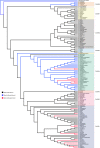Soral synapomorphies are significant for the systematics of the Ustilago-Sporisorium-Macalpinomyces complex (Ustilaginaceae)
- PMID: 23606766
- PMCID: PMC3589796
- DOI: 10.3767/003158512X660562
Soral synapomorphies are significant for the systematics of the Ustilago-Sporisorium-Macalpinomyces complex (Ustilaginaceae)
Abstract
The genera Ustilago, Sporisorium and Macalpinomyces are a polyphyletic complex of plant pathogenic fungi. The four main morphological characters used to define these genera have been considered homoplasious and not useful for resolving the complex. This study re-evaluates character homology and discusses the use of these characters for defining monophyletic groups recovered from a reconstructed phylogeny using four nuclear loci. Generic delimitation of smut fungi based on their hosts is also discussed as a means for identifying genera within this group. Morphological characters and host specificity can be used to circumscribe genera within the Ustilago-Sporisorium-Macalpinomyces complex.
Keywords: Ustilaginales; columella; maximum likelihood; morphology; peridium; smut fungi; spore balls; sterile cells; systematics.
Figures







References
-
- Bakkeren G, Kronstad JW, Levesque CA. 2000. Comparison of AFLP fingerprints and ITS sequences as phylogenetic markers in Ustilaginomycetes. Mycologia 92: 510–521
-
- Bauer R, Begerow D, Oberwinkler F, Piepenbring M, Berbee ML. 2001. Ustilaginomycetes. In: McLaughlin DJ, McLaughlin EG, Lemke PA. (eds), Mycota VII Part B Systematics and evolution: 57–83 Springer-Verlag, Berlin
-
- Bauer R, Oberwinkler F, Vánky K. 1997. Ultrastructural markers and systematics in smut fungi and allied taxa. Canadian Journal of Botany 75: 1273– 1314
-
- Begerow D, Bauer R, Oberwinkler F. 1997. Phylogenetic studies on nuclear large subunit ribosomal DNA sequences of smut fungi and related taxa. Canadian Journal of Botany 75: 2045–2056
LinkOut - more resources
Full Text Sources
Molecular Biology Databases
